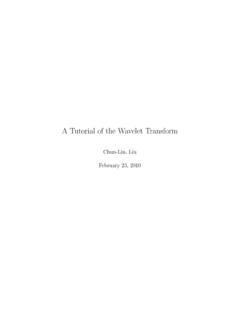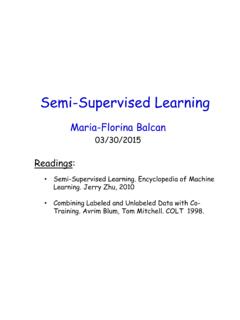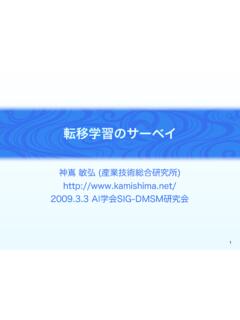Transcription of Machine Learning Tutorial
1 1 Machine Learning Tutorial Wei-Lun Chao, First edited in December, 2011 DISP Lab, Graduate Institute of Communication Engineering, National Taiwan University Contents 1. Introduction 3 2. What is Machine Learning 4 Notation of Dataset 4 Training Set and Test Set 4 No Free Lunch Rule 6 Relationships with Other Disciplines 7 3. Basic Concepts and Ideals of Machine Learning 8 Designing versus Learning 8 The Categorization of Machine Learning 9 The Structure of Learning 10 What are We Seeking?
2 13 The Optimization Criterion of Supervised Learning 14 The Strategies of Supervised Learning 20 4. Principles and Effects of Machine Learning 22 The VC bound and Generalization Error 23 Three Learning Effects 24 Feature Transform 29 Model Selection 32 Three Learning Principles 35 Practical Usage: The First Glance 35 5. Techniques of Supervised Learning 37 Supervised Learning Overview 37 Linear Model (Numerical Functions) 39 Perceptron Learning Algorithm (PLA) Classification 40 From Linear to Nonlinear 41 Adaptive Perceptron Learning Algorithm (PLA) Classification 43 Linear Regression Regression 46 Rigid Regression Regression 47 Support Vector Machine (SVM) and Regression (SVR)
3 48 2 Extension to Multi-class Problems 49 Conclusion and Summary 50 6. Techniques of Unsupervised Learning 51 7. Practical Usage: Pattern Recognition 52 8. Conclusion 53 Notation ()()General notation:: scalar: vector: matrix: the th entry of : the entry ( , ) of : the th vector in a dataset: the th matrix in a dataset: the vector corresponding to the thiijnnkaAaiai jAnAnAkaaaab()() class in a dataset (or th component in a model): the matrix corresponding to the th class in a dataset (or th component in a model): the th vector of the th class in a dataset, , :kiknkkBkkikAABb() the number of column vectors in , , and Special notation:* In some conditions, some special notations will be used and desribed at those : denotes a -dimensional vector, and nkkk jA ABkB bdenotes a matrixkj 3 1.
4 Introduction In the topics of face recognition, face detection, and facial age estimation, Machine Learning plays an important role and is served as the fundamental technique in many existing literatures. For example, in face recognition, many researchers focus on using dimensionality reduction techniques for extracting personal features. The most well-known ones are (1) eigenfaces [1], which is based on principal component analysis (PCA,) and (2) fisherfaces [2], which is based on linear discriminant analysis (LDA). In face detection, the popular and efficient technique based on Adaboost cascade structure [3][4], which drastically reduces the detection time while maintains comparable accuracy, has made itself available in practical usage. Based on our knowledge, this technique is the basis of automatic face focusing in digital cameras.
5 Machine Learning techniques are also widely used in facial age estimation to extract the hardly found features and to build the mapping from the facial features to the predicted age. Although Machine Learning is not the only method in pattern recognition (for example, there are still many researches aiming to extract useful features through image and video analysis), it could provide some theoretical analysis and practical guidelines to refine and improve the recognition performance. In addition, with the fast development of technology and the burst usage of Internet, now people can easily take, make, and access lots of digital photos and videos either by their own digital cameras or from popular on-line photo and video collections such as Flicker [5], Facebook [6], and Youtube [7].
6 Based on the large amount of available data and the intrinsic ability to learn knowledge from data, we believe that the Machine Learning techniques will attract much more attention in pattern recognition, data mining, and information retrieval. In this Tutorial , a brief but broad overview of Machine Learning is given, both in theoretical and practical aspects. In Section 2, we describe what Machine Learning is and its availability. In Section 3, the basic concepts of Machine Learning are presented, including categorization and Learning criteria. The principles and effects about the Learning performance are discussed in Section 4, and several supervised and unsupervised Learning algorithms are introduced in Sections 5 and 6. In Section 7, a general framework of pattern recognition based on Machine Learning technique is provided.
7 Finally, in Section 8, we give a conclusion. 4 2. What is Machine Learning ? Optimizing a performance criterion using example data and past experience , said by E. Alpaydin [8], gives an easy but faithful description about Machine Learning . In Machine Learning , data plays an indispensable role, and the Learning algorithm is used to discover and learn knowledge or properties from the data. The quality or quantity of the dataset will affect the Learning and prediction performance. The textbook (have not been published yet) written by Professor Hsuan-Tien Lin, the Machine Learning course instructor in National Taiwan University (NTU), is also titled as Learning from Data , which emphasizes the importance of data in Machine Learning . Fig. 1 shows an example of two-class dataset. Notation of Dataset Before going deeply into Machine Learning , we first describe the notation of dataset, which will be used through the whole section as well as the Tutorial .
8 There are two general dataset types. One is labeled and the other one is unlabeled: Labeled dataset : ()1{}nd NnXR x, ()1{}nNnYyR Unlabeled dataset : ()1{}nd NnXR x , where X denotes the feature set containing N samples. Each sample is a d-dimensional vector( )( )( )( )12[,,..,]nnnnTdxxx xand called a feature vector or feature sample, while each dimension of a vector is called an attribute, feature, variable, or element. Y stands for the label set, recording what label a feature vector corresponds to (the color assigned on each point in Fig. 1). In some applications, the label set is unobserved or ignored. Another form of labeled dataset is described as( )( )1{,}ndnNnR yR x, where each( )( ){,}nnxyis called a data pair. Training Set and Test Set In Machine Learning , an unknown universal dataset is assumed to exist, which contains all the possible data pairs as well as their probability distribution of 5 appearance in the real world.
9 While in real applications, what we observed is only a subset of the universal dataset due to the lack of memory or some other unavoidable reasons. This acquired dataset is called the training set (training data) and used to learn the properties and knowledge of the universal dataset. In general, vectors in the training set are assumed independently and identically sampled ( ) from the universal dataset. Fig. 1 An example of two-class dataset is showed, where two measurements of each sample are extracted. In this case, each sample is a 2-D vector [9]. In Machine Learning , what we desire is that these learned properties can not only explain the training set, but also be used to predict unseen samples or future events. In order to examine the performance of Learning , another dataset may be reserved for testing, called the test set or test data.
10 For example, before final exams, the teacher may give students several questions for practice (training set), and the way he judges the performances of students is to examine them with another problem set (test set). In order to distinguish the training set and the test set when they appear together, we usetrain and test to denote them, respectively. We have not clearly discussed what kinds of properties can be learned from the dataset and how to estimate the Learning performance, while the readers can just leave it as a black box and go forth. In Fig. 2, an explanation of the three datasets above is presented, and the first property a Machine can learn in a labeled data set is shown, the separating boundary. 6 Fig. 2 An explanation of three labeled datasets. The universal set is assumed to exist but unknown, and through the data acquisition process, only a subset of universal set is observed and used for training (training set).







